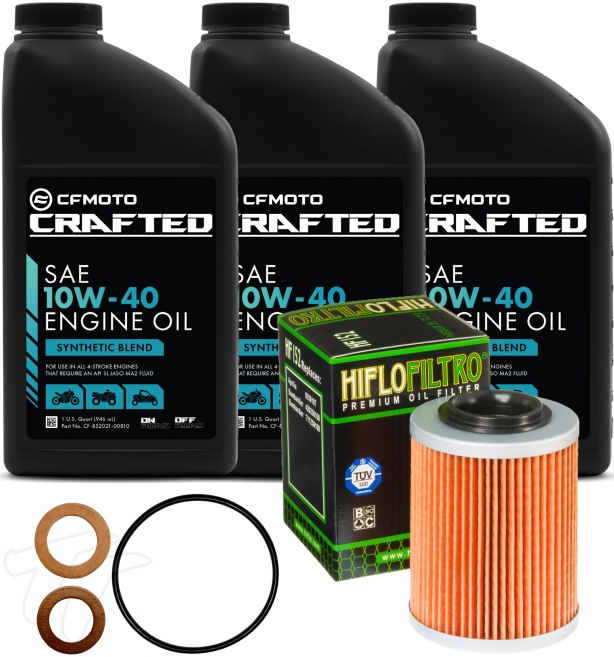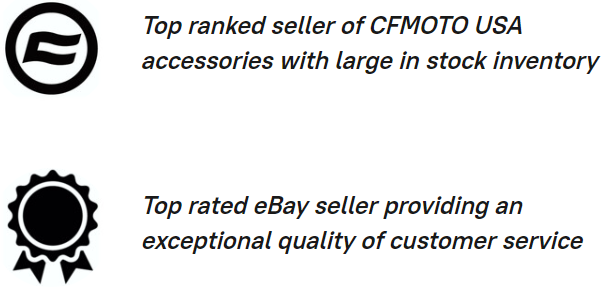|
When it comes to maintenance of any CFMOTO ATV/UTV Side x Side, the most basic is changing the oil. What are the best, recommended oil options for any model CFORCE/ZFORCE/UFORCE 400/500/600/800/1000cc engine? There are two main types of engine oils: mineral oils and synthetic oils. In addition, it's important to understand the viscosity grade of engine oils. Let’s explore their features and differences.
|
What is the Viscosity Grade of Engine Oil?
The viscosity grade of engine oil provides information on the oil’s resistance to flow inside the engine. A lubricant with a low viscosity grade will be more fluid and flow more easily. The higher the grade, the thicker the oil, slowing its flow to help form a protective film across engine parts.
As engine oil is affected by temperature, its grade gives information on the use and flow of the lubricant when hot and cold. For example:
What is Mineral Engine Oil?
Mineral engine oils are derived from the refining of crude petroleum. During the process, natural contaminants and unwanted hydrocarbons are removed. Mineral oils do flow through engine circuits slower than synthetic oils, which can result in increased fuel consumption and impacted vehicle performance. However, mineral oils can still provide high-quality lubrication, usually more so than synthetic lubricants, and slightly less expensive.
What is Synthetic Engine Oil?
Synthetic engine oils are a product of complex chemical transformations that are performed either directly on drilled crude petroleum or using preselected molecules. The difference with mineral oils resides in the transformation process: synthetic oil undergoes more sophisticated modification.
Key points on synthetic oils:
What are the Advantages of Synthetic Oils?
Synthetic oils offer many advantages:
What is the Difference Between Synthetic and Semi-Synthetic Engine Oils?
There are several factors that set semi-synthetic engine oils apart from fully synthetic lubricants:
The viscosity grade of engine oil provides information on the oil’s resistance to flow inside the engine. A lubricant with a low viscosity grade will be more fluid and flow more easily. The higher the grade, the thicker the oil, slowing its flow to help form a protective film across engine parts.
As engine oil is affected by temperature, its grade gives information on the use and flow of the lubricant when hot and cold. For example:
- At low temperatures, it is better to choose an oil with a low viscosity grade to facilitate circulation of the lubricant in your vehicle during a cold engine start.
- Engine oil with a higher grade will be more resistant in the hotter, more sensitive parts of the engine. As it is thicker, the oil will form a protective film on the engine parts, reducing wear and breakage by preventing friction between parts.
What is Mineral Engine Oil?
Mineral engine oils are derived from the refining of crude petroleum. During the process, natural contaminants and unwanted hydrocarbons are removed. Mineral oils do flow through engine circuits slower than synthetic oils, which can result in increased fuel consumption and impacted vehicle performance. However, mineral oils can still provide high-quality lubrication, usually more so than synthetic lubricants, and slightly less expensive.
What is Synthetic Engine Oil?
Synthetic engine oils are a product of complex chemical transformations that are performed either directly on drilled crude petroleum or using preselected molecules. The difference with mineral oils resides in the transformation process: synthetic oil undergoes more sophisticated modification.
Key points on synthetic oils:
- They contain fewer impurities than mineral oils
- They are chemically modified
What are the Advantages of Synthetic Oils?
Synthetic oils offer many advantages:
- Excellent flow at low temperatures
- Stable viscosity, even at high temperatures
- Less deposit formation
- Less wear on parts
- Optimize fuel consumption
- Protect engines and increase their lifespans
What is the Difference Between Synthetic and Semi-Synthetic Engine Oils?
There are several factors that set semi-synthetic engine oils apart from fully synthetic lubricants:
- Semi-synthetic oils contain a mix of conventional 100% synthetic and mineral oils.
- There is no single industry definition of what they should constitute.
- Generally, semi-synthetic oils are more expensive than mineral oils and cheaper than fully synthetic oils.
- Semi-synthetic lubricants offer fewer performance enhancements, protect components less and degrade faster than synthetic oils.
- Semi-synthetic oils are purer, better-flowing, and longer-lasting than mineral oils.
CFMOTO Oil Change Kits
|
If you are looking for the convenience of a CFMOTO engine oil change kit, choose TT Motorsports. Our kits are universal fitment for most 2013-newer CFORCE/ZFORCE/UFORCE ATV/UTV side by sides, and include oil, filter, o-ring, and washer meeting factory specifications. Regardless of what type of oil you use, you should still change the oil according to your CFMOTO manufacturer owner’s manual and direct any service-related questions to your local dealership.
|





